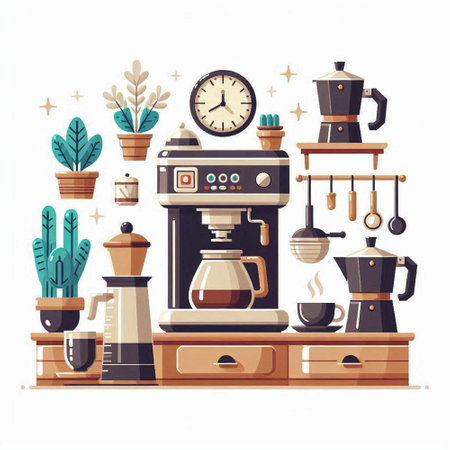Choosing the Perfect Spot for Your Coffee Bar
When it comes to setting up your first home coffee bar, the location within your home is absolutely key. In true British style, making the most of every inch in your kitchen or living space is essential. Start by scouting out a nook that’s bathed in natural light—nothing beats brewing your morning coffee as sunlight pours in through a sash window. Not only does this create an inviting atmosphere, but it also makes those Instagram-worthy flat whites look even more appealing.
Next, consider practicality. Ensure your chosen spot is within easy reach of plug sockets; after all, most essential coffee equipment, from espresso machines to grinders and milk frothers, will need reliable power. Trailing extension leads across the worktop simply won’t do in a well-organised British kitchen.
If you’re short on space—a common challenge in UK homes—think vertically. Utilise shelves above your workspace for mugs and beans, or repurpose an unused alcove or corner of the kitchen. A stylish trolley or sideboard can transform into a portable coffee station, perfect for those who love to entertain or prefer flexibility. Ultimately, selecting the ideal spot blends function and charm, ensuring your new coffee bar feels like a natural part of your home while capturing that quintessentially British sense of comfort and style.
Essential Coffee Equipment You’ll Need
Setting up your first home coffee bar is all about finding the right balance between practicality and personal taste. To help you craft a truly British coffee experience, here’s a breakdown of the must-have equipment every beginner should consider. Whether you prefer a fuss-free cafetière or dream of pulling your own espresso shots, this guide covers the essentials.
Kettles: The Heart of British Brewing
No British kitchen is complete without a trusty kettle. For coffee enthusiasts, an electric gooseneck kettle gives you precise control over water flow—a real advantage for pour-over methods and cafetières alike. Look for models with variable temperature settings, as different beans and brewing styles benefit from specific water temperatures.
Grinders: Unlock Freshness
Freshly ground coffee makes all the difference. Choose a burr grinder over a blade grinder for consistent grind size—crucial whether you’re using an espresso machine or a classic cafetière (French press). Here’s a handy comparison:
| Grinder Type | Best For | Pros | Cons |
|---|---|---|---|
| Burr Grinder | Espresso, Filter, Cafetière | Consistent grind, better flavour extraction | More expensive |
| Blade Grinder | Cafetière, Pour-over | Affordable, compact | Inconsistent grind size |
Cafetière: A British Staple
The cafetière (or French press) remains a beloved choice in UK homes. It’s simple to use and perfect for sharing a leisurely brew at breakfast. Choose one with sturdy glass and stainless steel for durability—a touch of vintage charm doesn’t hurt either.
Espresso Machines: Café-Quality at Home
If you’re keen on lattes or flat whites (a true British favourite these days), consider investing in a home espresso machine. Entry-level pump machines are affordable and user-friendly, while more advanced models offer greater control and steaming power for silky microfoam.
Other Essentials: Don’t Forget These!
- Scales: Precise weighing ensures consistency in every cup.
- Tamper: Essential for espresso lovers to compress grounds evenly.
- Milk Frother: For those who love their cappuccinos and lattes creamy and smooth.
- Coffee Storage: Airtight containers keep your beans fresh—always store them away from sunlight and moisture.
Your Coffee Bar, Your Way
The beauty of building your home coffee bar lies in tailoring it to your daily rituals. Whether it’s a quick morning cafetière or indulging in an afternoon espresso, these essential tools set the stage for countless comforting cups—British style.

3. Selecting the Right Coffee Beans and Tea Alternatives
When setting up your first home coffee bar, sourcing quality coffee beans is absolutely essential to creating an authentic café experience. Start by exploring local UK roasters—many towns and cities boast independent roasteries with unique blends and single-origin beans. Ask for recommendations or visit local markets to sample their offerings; you’ll not only find fresher beans but also support small businesses in your community. Look for roast dates on packaging and opt for whole beans if possible, grinding them just before brewing to ensure maximum freshness and aroma.
For those who like a bit of variety or want to honour beloved British traditions, don’t overlook tea alternatives. Stock up on classic black teas such as Earl Grey or English Breakfast, which are staples in most UK households. For a more contemporary twist, consider artisan loose-leaf blends from local tea merchants—think fragrant Darjeeling, malty Assam, or even herbal infusions like peppermint and chamomile for caffeine-free options.
Ultimately, curating a selection of both quality coffee beans and fine teas allows you to tailor your home bar to every taste and occasion. Whether it’s the rich aroma of freshly brewed coffee or the comforting ritual of afternoon tea, these thoughtful choices will help transform your kitchen into a welcoming space that reflects true British hospitality.
4. Creating a Cosy & Stylish Coffee Nook
Turning your home coffee bar into a truly inviting space is all about blending function with British flair. Whether you have a dedicated corner or a petite countertop, styling your coffee nook to echo classic British charm will make every morning brew feel special. Here’s how you can add those quintessential touches:
Embrace Vintage Mugs & Crockery
No British coffee bar is complete without a collection of vintage mugs or bone china cups. Seek out pieces from charity shops or local markets—floral patterns, pastel glazes, and delicate handles evoke that timeless English tea room atmosphere but for your daily coffee ritual.
Tasteful Storage Solutions
Organisation is key, but it doesn’t have to be boring. Opt for stylish canisters, preferably in muted tones or classic enamel, to store your beans and grounds. A wooden tray or tiered cake stand can double as a display for sugar bowls and spoons. Below is a handy table to inspire your storage setup:
| Item | Classic British Touch |
|---|---|
| Coffee Canister | Ceramic with script label |
| Sugar Bowl | Blue and white porcelain |
| Spoon Holder | Pewter cup or mini milk jug |
| Tray | Vintage floral or wooden serving tray |
A Sprinkle of Personality
Your coffee bar should reflect who you are. Add framed art prints—perhaps a cheeky British phrase or a watercolour of an English garden. Incorporate small potted plants, like English ivy or rosemary, for a fresh touch. Don’t forget a cosy lamp or fairy lights for those overcast mornings!
Quick Tips for That Homey Feel
- Layer textures with linen napkins or doilies under mugs.
- Display a stack of well-loved recipe books nearby.
- Add a small chalkboard for your daily brew inspiration.
With these thoughtful details, your home coffee bar becomes more than just functional—it’s a stylish sanctuary where you can savour each cup with unmistakable British character.
5. The Art of Brewing: Getting Your Basics Right
When you’re just starting out with your home coffee bar, there’s no need to dive straight into complicated techniques. The key is to master a few simple brewing methods that deliver consistently good results—perfect for those busy British mornings or a relaxed weekend treat. Let’s explore some beginner-friendly approaches that will help you build confidence and discover your favourite cup.
French Press: Effortless Elegance
The French Press is a classic choice beloved across the UK for its straightforward process and rich flavour. All you need is coarsely ground coffee, hot water (just off the boil), and a timer. Add coffee and water in the right proportions, stir, pop on the lid, and let it steep for about four minutes before pressing down slowly. You’ll have a robust brew with minimal fuss—ideal for enjoying in your kitchen nook or taking out to the garden.
AeroPress: Quick and Versatile
If you’re short on time but still want quality, the AeroPress is a clever bit of kit. It’s compact, easy to clean, and produces a smooth cup with little bitterness. Simply add ground coffee and water, stir, then press gently after a short steep. With its flexibility, you can experiment with recipes once you’ve got the basics down—think espresso-style shots or longer Americanos for lazy Sunday mornings.
Pour Over: Precision Meets Simplicity
The pour over method might look fancy, but it’s wonderfully approachable. Using a V60 dripper or Chemex, place your filter and grounds, then pour hot water slowly in circular motions. It’s all about patience and enjoying the ritual—a perfect way to start your day with intention. Once you find your preferred grind size and pouring technique, this method reveals delicate flavours often missed by other brewers.
Consistency Is Key
No matter which method you choose, the secret lies in consistency—use scales for accuracy, timers for precision, and keep notes as you experiment. This not only helps refine your skills but also ensures every morning brew feels like an occasion rather than a chore.
Top Tip: Don’t Forget Water Quality
British tap water varies from region to region; if your brews taste a bit flat or harsh, try filtered water for a brighter cup.
Mastering these basic brewing methods will set you up nicely as you begin your home coffee journey. As your confidence grows, so too will your desire to explore more elaborate recipes and equipment—but for now, enjoy the process of perfecting your daily cup.
6. Maintaining Your Equipment for Longevity
Building your dream home coffee bar is just the beginning—the key to consistently great brews is keeping your equipment in top nick. From espresso machines to grinders, proper maintenance not only prolongs the lifespan of your gear but also ensures every cup tastes as intended. Here are some essential tips tailored for UK coffee lovers keen on making their daily ritual a lasting pleasure.
Regular Cleaning: A Non-Negotiable Ritual
Every bit of kit, from your French press to your bean grinder, needs a regular spruce-up. Rinse removable parts after each use and give them a thorough wash with warm soapy water weekly. For espresso machines, run clean water through the system daily and descale monthly using a recommended solution—hard London water can be particularly tough on internal pipes.
Grinder Care: Keeping Flavours Pure
Your grinder is the unsung hero of your setup. To avoid unwanted flavours, brush out excess grounds after each use and deep-clean blades or burrs fortnightly. Don’t forget to check the manufacturer’s guide for specific cleaning advice, especially if you’re dealing with an electric burr grinder—a little TLC goes a long way.
Storage Tips: Protecting Your Investment
Store all equipment in a dry spot away from direct sunlight—moisture and heat can degrade both machinery and beans. If you’re short on space, invest in sleek canisters for beans and a compact rack for tools; it keeps your worktop tidy and your gear easy to access.
Spotting Signs of Wear
Pay attention to how your machine sounds and performs. Any odd noises, inconsistent brewing times or leaks could signal it’s time for a service or replacement part. Most reputable UK suppliers offer servicing—don’t hesitate to book yours in before problems brew up.
The British Touch: Keeping It Sustainable
Finally, go easy on the planet by using eco-friendly cleaning products where possible and recycling used filters or pods responsibly. Not only will this keep your conscience clear, but it’ll make sure your home coffee bar remains a sustainable source of joy for years to come.
Treating your coffee equipment with care means every morning cuppa tastes as brilliant as the last—cheers to that!


